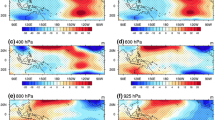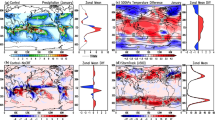Abstract
The effects of sea surface temperature (SST), radiation, cloud microphysics, and diurnal variations on the vertical structure of tropical tropospheric temperature are investigated by analyzing 10 two-dimensional equilibrium cloud-resolving model simulation data. The increase of SST, exclusion of diurnal variation of SST, and inclusion of diurnal variation of solar zenith angle, radiative effects of ice clouds, and ice microphysics could lead to tropical tropospheric warming and increase of tropopause height. The increase of SST and the suppression of its diurnal variation enhance the warming in the lower and upper troposphere, respectively, through increasing latent heat and decreasing IR cooling. The inclusion of diurnal variation of solar zenith angle increases the tropospheric warming through increasing solar heating. The inclusion of cloud radiative effects increases tropospheric warming through suppressing IR cooling in the mid and lower troposphere and enhancing solar heating in the upper troposphere. The inclusion of ice microphysics barely increases warming in the mid and lower troposphere because the warming from ice radiative effects is nearly offset by the cooling from ice microphysical effects, whereas it causes the large warming enhancement in the upper troposphere due to the dominance of ice radiative effects. The tropopause height is increased mainly through the large enhancement of IR cooling.











Similar content being viewed by others
References
Austin J, Reichler TJ (2008) Long-term evolution of the cold point tropical tropopause: simulation results and attribution analysis. J Geophys Res 113:D00B10. doi:10.1029/2007JD009768
Chou M-D, Suarez MJ (1994) An efficient thermal infrared radiation parameterization for use in general circulation model. NASA Tech Memo 104606, vol 3, 85 pp (Available from NASA/Goddard Space Flight Center, Code 913, Greenbelt, MD 20771)
Chou M-D, Kratz DP, Ridgway W (1991) Infrared radiation parameterization in numerical climate models. J Clim 4:424–437
Chou M-D, Suarez MJ, Ho C-H, Yan MM-H, Lee K-T (1998) Parameterizations for cloud overlapping and shortwave single scattering properties for use in general circulation and cloud ensemble models. J Atmos Sci 55:201–214
Cui X, Gao S (2008) Effects of zonal perturbations of sea surface temperature on tropical equilibrium states: a cloud-resolving modeling study. Prog Nat Sci 18:413–419
Fomichev VI, Johnson AI, Grandpre JDE, Beagley SR, McLandress C, Semeniuk K, Shepherd TG (2007) Response of the middle atmosphere to CO2 doubling: results from the Canadian Middle Atmosphere Model. J Clim 20:1121–1144
Gao S (2007) A three-dimensional dynamic vorticity vector associated with tropical oceanic convection. J Geophys Res 112:D18109. doi:10.1029/2006JD008247
Gao S (2008) A cloud-resolving modeling study of cloud radiative effects on tropical equilibrium states. J Geophys Res 113:03108. doi:10.1029/2007JD009177
Gao S, Li X (2008) Cloud-resolving modeling of convective processes. Springer, Heidelberg, 206 pp
Gao S, Ping F, Li X, Tao W-K (2004) A convective vorticity vector associated with tropical convection: a two-dimensional cloud-resolving modeling study. J Geophys Res 109:D14106. doi:10.1029/2004JD004807
Gao S, Cui X, Zhou Y, Li X, Tao W-K (2005) A modeling study of moist and dynamic vorticity vectors associated with 2D tropical convection. J Geophys Res 110:D17104. doi:10.1029/2004JD005675
Gao S, Ran L, Li X (2006) Impacts of ice microphysics on rainfall and thermodynamic processes in the tropical deep convective regime: a 2D cloud-resolving modeling study. Mon Weather Rev 134:3015–3024
Gao S, Li X, Tao W-K, Shie C-L, Lang S (2007a) Convective and moist vorticity vectors associated with tropical oceanic convection: a three-dimensional cloud-resolving simulation. J Geophys Res 112:D01105. doi:10.1029/2006JD007179
Gao S, Zhou Y, Li X (2007b) Effects of diurnal variations on tropical equilibrium states: a two-dimensional cloud-resolving modeling study. J Atmos Sci 64:656–664
Grabowski WW, Moncrieff MW, Kiehl JT (1996) Long-term behaviour of precipitating tropical cloud systems: a numerical study. Q J R Meteorol Soc 122:1019–1042
Grabowski WW, Wu X, Moncrieff MW, Hall WD (1998) Cloud-resolving model of tropical cloud systems during Phase III of GATE. Part II: effects of resolution and the third spatial dimension. J Atmos Sci 55:3264–3282
Khairoutdinov MF, Randall DA (2003) Cloud-resolving modeling of the ARM summer 1997 IOP: model formulation, results, uncertainties, and sensitivities. J Atmos Sci 60:607–625
Knutson TR, Delworth TL, Dixon KW, Held IM, Lu J, Ramaswamy V, Schwarzkopf MD (2006) Assessment of twentieth-century regional surface temperature trends using the GFDL CM2 coupled models. J Clim 19:1624–1651
Krueger SK, Fu Q, Liou KN, Chin H-NS (1995) Improvement of an ice-phase microphysics parameterization for use in numerical simulations of tropical convection. J Appl Meteorol 34:281–287
Lau K-M, Sui C-H, Chou M-D, Tao W-K (1994) An inquiry into the cirrus cloud thermostat effect for tropical sea surface temperature. Geophys Res Lett 21:1157–1160
Li X, Sui C-H, Lau K-M, Chou M-D (1999) Large-scale forcing and cloud–radiation interaction in the tropical deep convective regime. J Atmos Sci 56:3028–3042
Lin Y-L, Farley RD, Orville HD (1983) Bulk parameterization of the snow field in a cloud model. J Clim Appl Meteor 22:1065–1092
Moncrieff MW, Miller MJ (1976) The dynamics and simulation of tropical cumulonimbus and squall line. Q J R Meteorol Soc 102:373–394
Nakajima K, Matsuno T (1988) Numerical experiments concerning the origin of cloud clusters in the tropical atmosphere. J Meteor Soc Jpn 66:309–329
Ping F, Luo Z, Li X (2007) Microphysical and radiative effects of ice microphysics on tropical equilibrium states: a two-dimensional cloud-resolving modeling study. Mon Weather Rev 135:2794–2802
Ramanathan V, Collins W (1991) Thermodynamic regulation of ocean warming by cirrus clouds deduced from observations of the 1987 El Nino. Nature 351:27–32
Robe FR, Emanuel KA (1996) Moist convective scaling: some inferences from three-dimensional cloud ensemble simulations. J Atmos Sci 53:3265–3275
Rotunno R, Klemp JB, Weisman ML (1988) A theory for strong, long-lived squall lines. J Atmos Sci 45:463–485
Rutledge SA, Hobbs PV (1983) The mesoscale and microscale structure and organization of clouds and precipitation in midlatitude cyclones. Part VIII: a model for the “seeder-feeder” process in warm-frontal rainbands. J Atmos Sci 40:1185–1206
Rutledge SA, Hobbs PV (1984) The mesoscale and microscale structure and organization of clouds and precipitation in midlatitude cyclones. Part XII: a diagnostic modeling study of precipitation development in narrow cold-frontal rainbands. J Atmos Sci 41:2949–2972
Santer BD, Wehner MF, Wigley TML, Sausen R, Meehl GA, Taylor KE, Ammann C, Arblaster J, Washington WM, Boyle JS, Bruggemann W (2003) Contributions of anthropogenic and natural forcing to recent tropopause height changes. Science 301:479–483
Santer BD, Wigley TML, Mears C, Wentz FJ, Klein SA, Seidel DJ, Taylor KE, Thorne PW, Wehner MF, Gleckler PJ, Boyle JS, Collins WD, Dixon KW, Doutriaux C, Free M, Fu Q, Hansen JE, Jones GS, Ruedy R, Karl TR, Lanzante JR, Heehl GA, Ramaswamy V, Russell G, Schmidt GA (2005) Amplification of surface temperature trends and variability in the tropical atmosphere. Science 309:1551–1556
Seidel DJ, Randel WJ (2006) Variability and trends in the global tropopause estimated from radiosonde data. J Geophys Res 111:21101. doi:10.1029/2006JD007363
Seidel DJ, Ross RJ, Angell JK, Reid GC (2001) Climatological characteristics of the tropical tropopause as revealed by radiosondes. J Geophys Res 106:7857–7878
Shie C-L, Tao W-K, Simpson J, Sui C-H (2003) Quasi-equilibrium states in the tropics simulated by a cloud-resolving model. Part I: specific features and budget analysis. J Clim 16:817–833
Soong ST, Ogura Y (1980) Response of tradewind cumuli to large-scale processes. J Atmos Sci 37:2035–2050
Soong ST, Tao WK (1980) Response of deep tropical cumulus clouds to mesoscale processes. J Atmos Sci 37:2016–2034
Sui C-H, Lau K-M, Tao W-K, Simpson J (1994) The tropical water and energy cycles in a cumulus ensemble model. Part I: equilibrium climate. J Atmos Sci 51:711–728
Sui C-H, Lau K-M, Takayabu YN, Short D (1997) Diurnal variations in tropical oceanic cumulus convection during TOGA COARE. J Atmos Sci 54:639–655
Sui C-H, Li X, Lau K-M (1998) Radiative-convective processes in simulated diurnal variations of tropical oceanic convection. J Atmos Sci 55:2345–2359
Sui C-H, Li X, Yang M-J, Huang H-L (2005) Estimation of oceanic precipitation efficiency in cloud models. J Atmos Sci 62:4358–4370
Tao W-K, Simpson J (1993) The Goddard Cumulus Ensemble model. Part I: model description. Terr Atmos Oceanic Sci 4:35–72
Tao W-K, Soong S-T (1986) The study of the response of deep tropical clouds to mesoscale processes: three-dimensional numerical experiments. J Atmos Sci 43:2653–2676
Tao W-K, Simpson J, Soong S-T (1987) Statistical properties of a cloud ensemble: a numerical study. J Atmos Sci 44:3175–3187
Tao W-K, Simpson J, McCumber M (1989) An ice-water saturation adjustment. Mon Weather Rev 117:231–235
Tao W-K, Simpson J, Sui C-H, Shie C-L, Zhou B, Lau K-M, Moncrieff MW (1999) Equilibrium states simulated by cloud-resolving models. J Atmos Sci 56:3128–3139
Tett SFB, Jones GS, Scott PA, Hill DC, Mitchell JFB, Allen MR, Ingram WJ, Johns TC, Johnson CE, Jones A, Roberts DL, Sexton DMH, Woodage MJ (2002) Estimation of natural and anthropogenic contributions to twentieth century temperature change. J Geophys Res 107. doi:10.1029/2000JD000028
Tompkins AM (2000) The impact of dimensionality on long-term cloud-resolving model simulations. Mon Weather Rev 128:1521–1535
Wu X, Moncrieff MW (1999) Effects of sea surface temperature and large-scale dynamics on the thermodynamic equilibrium state and convection over the tropical western Pacific. J Geophys Res 104:6093–6100
Xu K-M, Randall DA (1999) A sensitivity study of radiative-convective equilibrium in the tropics with a convection-resolving model. J Atmos Sci 56:3385–3399
Xu K-M, Cederwall RT, Donner LJ, Grabowski WW, Guichard F, Johnson DE, Khairoutdinov M, Krueger SK, Petch JC, Randall DA, Seman CJ, Tao W-K, Wang D, Xie SC, Yio JJ, Zhang M-H (2002) An intercomparison of cloud resolving models with the Atmospheric Radiation Measurement summer 1997 Intensive Observation Period data. Q J R Meteorol Soc 128:593–624
Zeng X, Tao W-K, Zhang M, Hou AY, Xie S, Lang S, Li X, O’C Starr D, Li X (2009) A contribution of ice nuclei to global warming. Q J R Meteorol Soc. doi:10.1012/qj.449
Zou CZ, Goldberg MD, Cheng Z, Grody NC, Sullivan JT, Cao C, Tarpley D (2006) Recalibration of microwave sounding unit for climate studies using simultaneous nadir overpass. J Geophys Res 111:19114. doi:10.1029/2005JD006798
Zou C-Z, Gao M, Goldberg MD (2009) Error structure and atmospheric temperature trends in observations from the microwave sounding unit. J Clim 22:1661–1681
Acknowledgments
The authors thank Drs. S. Gao and F. Ping at the institute of Atmospheric Physics, Chinese Academy of Sciences, Beijing, China for providing us their 10 two-dimensional equilibrium cloud-resolving model simulation data, and two anonymous reviewers for their constructive comments. The manuscript contents are solely the opinions of the authors and do not constitute a statement of policy, decision, or position on behalf of NOAA or the US Government.
Author information
Authors and Affiliations
Corresponding author
Rights and permissions
About this article
Cite this article
Li, X., Zou, CZ. Effects of sea surface temperature, radiation, cloud microphysics, and diurnal variations on vertical structures of tropical tropospheric temperature: a two-dimensional equilibrium cloud-resolving modeling study. Meteorol Atmos Phys 105, 85–98 (2009). https://doi.org/10.1007/s00703-009-0039-2
Received:
Accepted:
Published:
Issue Date:
DOI: https://doi.org/10.1007/s00703-009-0039-2




